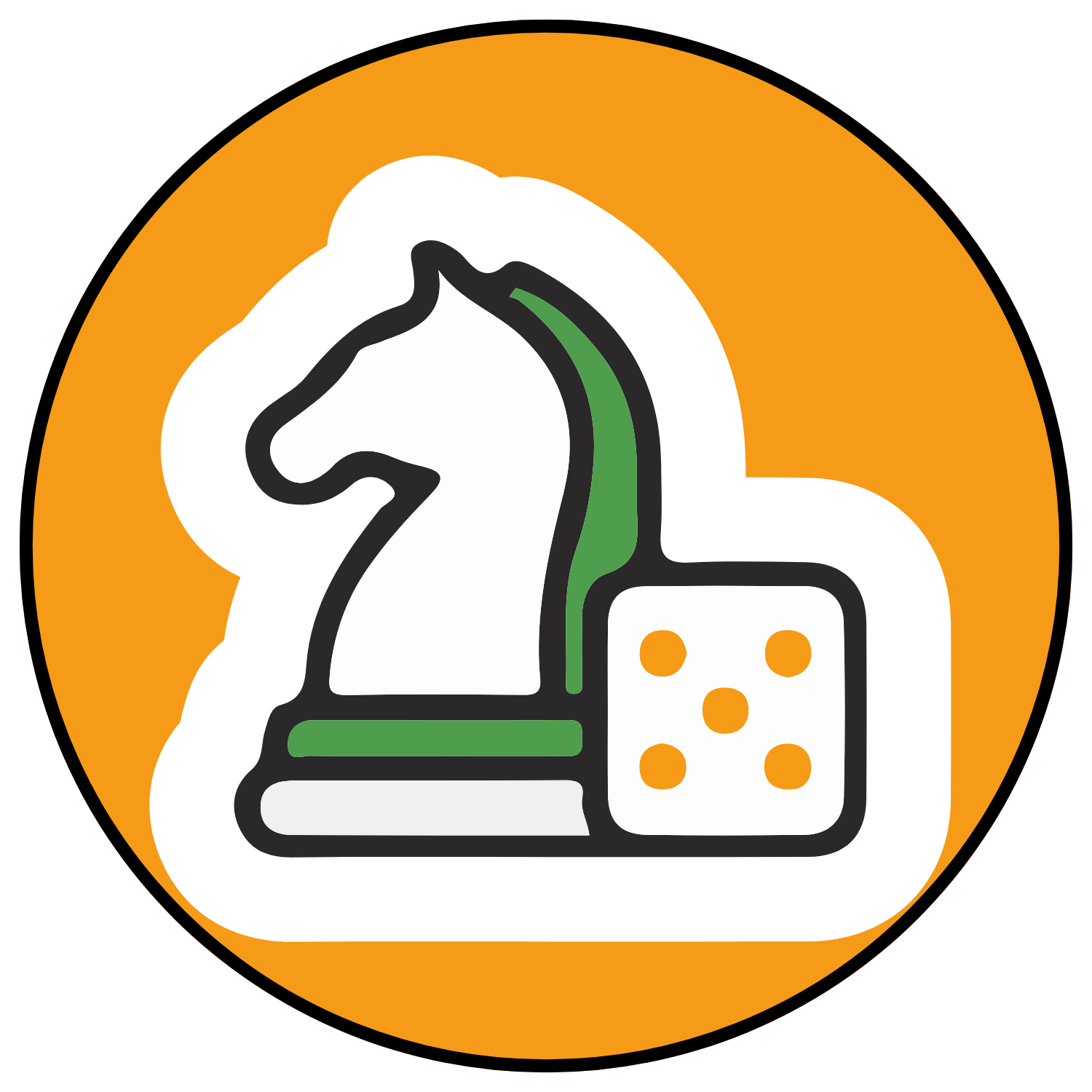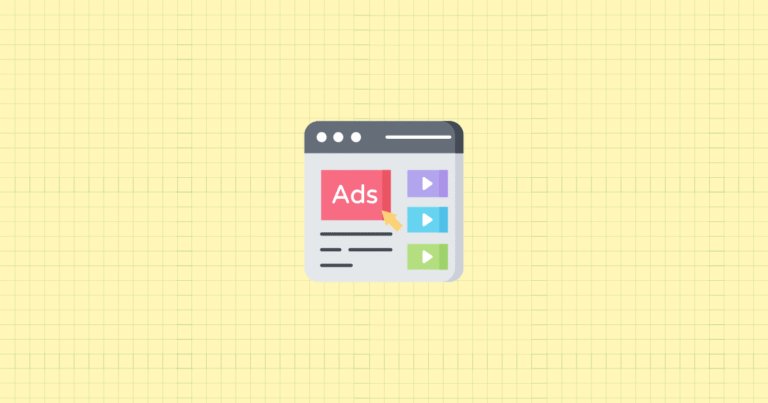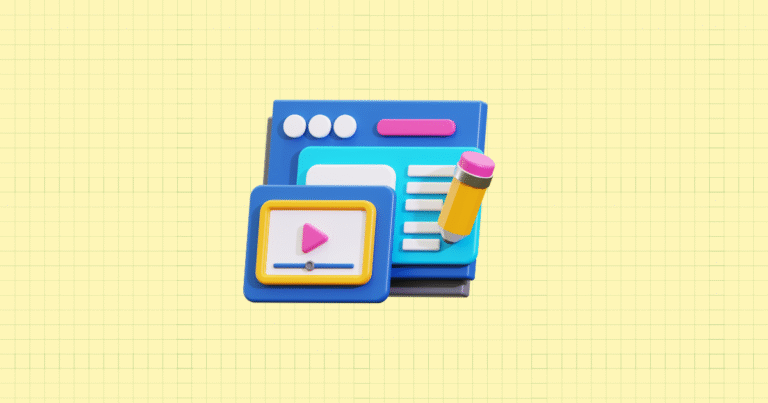Introduction to Search Ads for Shopify Stores
You’re staring at your Shopify dashboard, watching traffic trickle in. Sales are happening, but not fast enough. Sound familiar? Here’s the thing about search ads that most Shopify store owners miss: they’re not just another marketing channel. They’re your direct line to customers who are actively looking to buy what you’re selling.
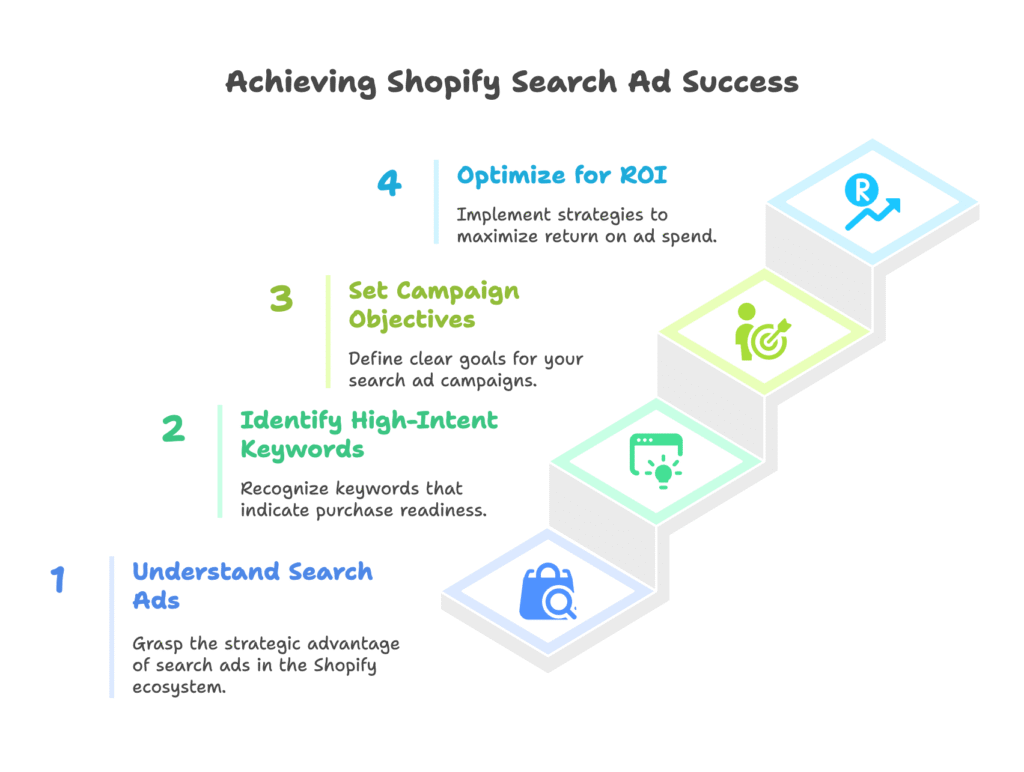
Think about it. When someone types “blue running shoes size 9” into Google, they’re not browsing. They’re buying. That’s the power of search advertising—connecting with customers at the exact moment they’re ready to purchase.
By the end of this guide, you’ll know exactly how to identify these high-intent keywords, structure campaigns that actually convert, and optimize your search ads for maximum ROI. We’re not talking theory here. This is practical, actionable strategy that works.
Understanding the Value of Search Ads in the Shopify Ecosystem
Search ads offer a strategic advantage that other marketing channels simply can’t match. Here’s why they’re particularly powerful for Shopify merchants:
Direct connection between search ads and purchase intent. When someone searches for your product, they’re already in buying mode. Unlike social media browsing or email marketing, search represents active demand. Your job isn’t to create desire—it’s to capture it.
Superior ROI compared to other marketing channels. The numbers don’t lie. Search ads consistently deliver some of the highest returns on ad spend because you’re targeting people who are already looking for what you sell. While cold traffic from social media might convert at 1-2%, search traffic often converts at 3-5% or higher.
Ability to target customers at precise buying stages. Not all searches are created equal. “Running shoes” suggests someone in research mode. “Nike Air Max 270 men’s size 10 buy now” screams purchase intent. Search ads let you target both, but with different strategies and budgets.
The search advertising landscape for Shopify stores includes several platform options. Google Ads remains the dominant player, offering the largest reach and most sophisticated targeting. Shopify Search Ads, while newer, provides native integration with your store. Performance benchmarks vary by industry, but e-commerce stores typically see click-through rates of 2-3% and conversion rates of 2-4% for well-optimized campaigns.
The Critical Role of Keyword Intent in Search Performance
Here’s where most Shopify store owners go wrong: they treat all keywords equally. Big mistake. The foundation of successful search advertising lies in understanding intent—the why behind each search.
Search engines evaluate relevance and intent through complex algorithms, but the principle is simple: match what people want with what you offer. When your keywords align perfectly with search intent, several things happen. Your ads get shown more often. You pay less per click. Most importantly, you convert more visitors into customers.
High-intent keywords are characterized by specific language patterns. Someone searching “best wireless headphones” is researching. Someone searching “Sony WH-1000XM4 buy online” is ready to purchase. The difference in conversion potential is enormous.
But here’s the challenge: high-intent keywords often have higher competition and costs. That’s where strategy comes in. You need to find the sweet spot between intent, competition, and your budget.
Setting Campaign Objectives for Shopify Search Ads
Before you write a single ad or bid on one keyword, you need crystal-clear objectives. Vague goals lead to mediocre results. Specific targets drive focused action.
Are you launching a new product line? Your objective might be awareness and initial sales volume. Clearing seasonal inventory? Focus on conversion rate and inventory turnover. Expanding into new markets? Customer acquisition cost becomes critical.
For most Shopify stores, these metrics matter most: Return on Ad Spend (ROAS) should typically be 4:1 or higher. Conversion rates vary by industry but aim for 2-4% for search traffic. Customer acquisition cost should leave room for repeat purchases and lifetime value.
Understanding Keyword Intent for Shopify Products
Every search tells a story. Your job is learning to read between the lines. When someone types a query into Google, they’re revealing where they are in their buying journey. Miss this, and you’re throwing money at the wrong audience.
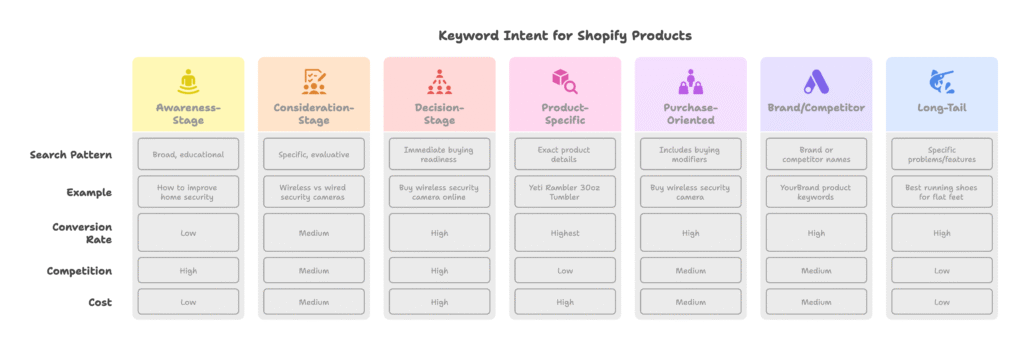
The Buyer’s Journey and Search Behavior
Let’s map out how people search when they’re moving from problem awareness to purchase. Understanding this progression changes everything about how you structure your campaigns.
Awareness-stage search patterns are broad and educational. Someone might search “how to improve home security” or “best home security systems.” They’re identifying a problem and exploring solutions. These keywords have low conversion rates but help establish your brand early in the process.
Consideration-stage query characteristics become more specific. Now they’re searching “wireless vs wired security cameras” or “Ring vs ADT comparison.” They’re evaluating options. These searchers convert better than awareness-stage browsers but still need nurturing.
High-intent decision-stage searches signal immediate buying readiness. “Ring Video Doorbell Pro sale,” “ADT security system installation near me,” or “buy wireless security camera online” indicate someone ready to purchase. These keywords cost more but convert at much higher rates.
Intent signals in e-commerce search queries include commercial modifiers like “buy,” “purchase,” “order,” “sale,” “discount,” and “best price.” These words dramatically increase the likelihood of conversion. Research language like “how to,” “what is,” or “guide” suggests someone in earlier stages.
Categories of High-Intent Keywords for Shopify Stores
Not all high-intent keywords look the same. Understanding the different categories helps you build comprehensive campaigns that capture demand from multiple angles.
Product-specific high-intent searches include exact product names, model numbers, and specific features. If you sell the “Yeti Rambler 30oz Tumbler,” someone searching that exact phrase is highly likely to buy. These keywords typically have the highest conversion rates but limited volume.
Purchase-oriented modifier terms transform any product keyword into a high-intent opportunity. Adding “buy,” “purchase,” “order,” “discount,” “coupon,” “deal,” “cheap,” “best price,” “for sale,” “in stock,” or “free shipping” to your product keywords increases intent signals significantly.
Brand and competitor terms present unique opportunities. Your own brand name plus product keywords capture people specifically looking for your store. Competitor brand plus product combinations capture people comparing options. Both deserve dedicated campaigns with different strategies.
Long-Tail Keywords and Commercial Intent
Here’s a secret most Shopify store owners overlook: longer, more specific keywords often outperform broad, popular terms. Why? Less competition, lower costs, and higher relevance.
Long-tail keywords offer several advantages for Shopify merchants. Lower competition means cheaper clicks. Higher relevance means better conversion rates. More specific searches indicate stronger purchase intent.
Instead of targeting “running shoes” (highly competitive), focus on “best running shoes for flat feet women size 8” (specific, lower competition, high intent). Someone searching the longer phrase knows exactly what they want and is closer to purchasing.
To identify valuable long-tail opportunities, think about specific problems your products solve. What exact features matter most? What questions do customers ask before buying? These insights reveal long-tail gold mines.
Keyword Research Methodology for Shopify Search Ads
Random keyword selection kills campaigns. Systematic research builds profitable ones. Let’s establish a methodology that uncovers the keywords your customers actually use when they’re ready to buy.
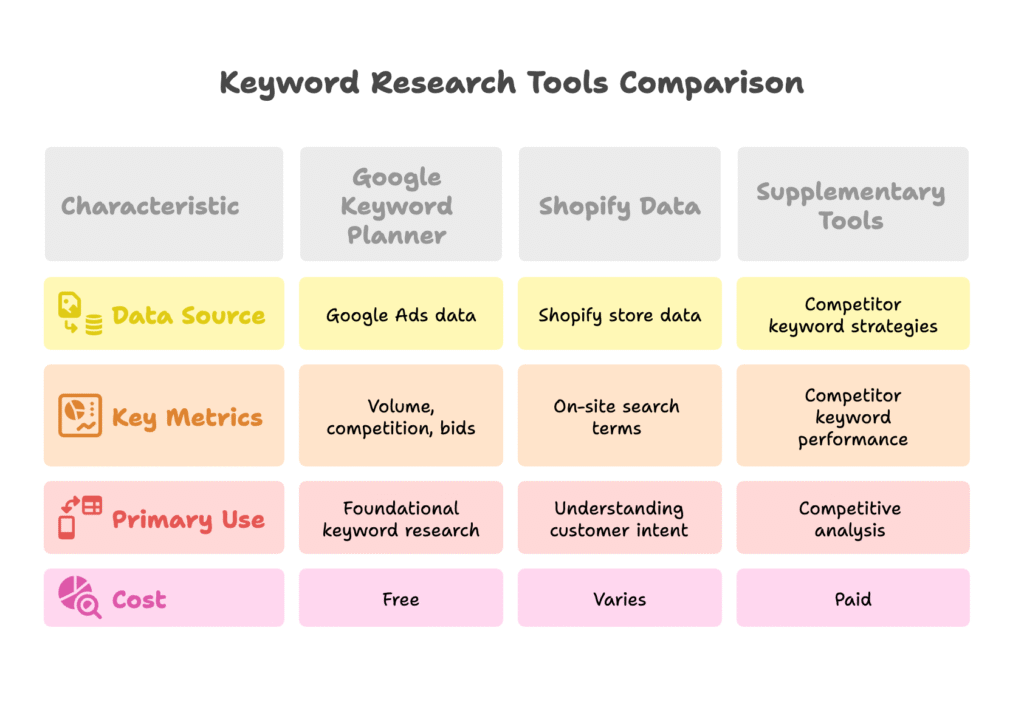
Essential Keyword Research Tools for Shopify Merchants
The right tools make keyword research efficient and effective. But tools alone don’t guarantee success—how you use them matters more than which ones you choose.
Google Keyword Planner remains the foundation of search advertising research. It’s free, directly integrated with Google Ads, and provides data straight from the source. Set it up by linking your Shopify store and Google Ads account. Focus on search volume trends, competition levels, and suggested bid ranges for your product categories.
But here’s what Google Keyword Planner doesn’t show: actual search queries used on your site. That’s where Shopify-specific data sources become invaluable. Your Shopify Analytics reveal what people search for once they reach your store. Google Search Console shows which queries already bring you organic traffic.
Supplementary tools like SEMrush, Ahrefs, or Ubersuggest help with competitive analysis. They reveal what keywords competitors target and how much they might be paying. This intelligence informs your bidding strategies and uncovers gaps in their campaigns.
Developing a Structured Keyword Research Process
Random keyword brainstorming leads nowhere. Follow this systematic approach to build comprehensive keyword lists that actually drive sales.
Start with core product seed keywords. List your main product categories, actual product names, and brand terms. Include the problems your products solve and the benefits they provide. This foundation ensures you don’t miss obvious opportunities.
Expand strategically using proven methods. Take each seed keyword and add relevant modifiers. “Running shoes” becomes “best running shoes,” “cheap running shoes,” “running shoes for women,” and “buy running shoes online.” Use synonyms to broaden reach without losing relevance.
Analyze competitor keywords systematically. What terms do successful competitors target? Which keywords do they rank for organically? What gaps exist in their coverage? This analysis reveals tested opportunities and untapped niches.
Evaluating and Prioritizing Keywords for Shopify Campaigns
Keyword research generates hundreds of potential terms. But not all keywords deserve equal attention or budget. You need a framework for separating gold from gravel.
Evaluate each keyword across four dimensions: search volume relative to your store size and budget, competition level in your niche, estimated cost-per-click for realistic budget planning, and direct relevance to your product catalog.
Prioritize strategically by considering ROI potential. High-value products can support higher cost-per-click. Seasonal relevance affects timing and budget allocation. Quick wins from low-competition, high-intent keywords provide early momentum.
Organize your final keyword list by intent and funnel position. Top-funnel awareness terms for content marketing and broad reach. Mid-funnel consideration keywords for nurture campaigns. Bottom-funnel high-intent terms for immediate revenue generation.
Building High-Converting Search Ad Campaigns
You’ve identified your high-intent keywords. Now comes the critical part: structuring campaigns that convert browsers into buyers. Poor campaign architecture wastes money faster than you can earn it back.
Structuring Effective Search Ad Campaigns in Google Ads
Campaign structure isn’t just organization—it’s strategy. How you group keywords and campaigns directly impacts performance, budget control, and optimization potential.
Organize campaigns by product collection or category. This alignment with your Shopify store structure makes management intuitive and performance tracking precise. Create separate campaigns for different product lines to control budgets independently and optimize messaging specifically.
Segment by customer intent type. Brand searches deserve dedicated campaigns with different messaging than generic product searches. High-intent commercial keywords need separate budgets from informational queries. This segmentation allows tailored bidding strategies and ad copy for each intent level.
Allocate budgets based on product margins. High-margin products can support aggressive bidding for premium positions. Lower-margin items need more conservative approaches. But remember: lifetime value matters more than first-purchase margins for subscription or repeat-purchase products.
Ad group organization within campaigns requires discipline. Group closely related keywords together—typically 10-20 keywords per ad group initially. This tight grouping enables relevant ad copy that speaks directly to search intent. As you gather performance data, split successful ad groups into smaller, more targeted segments.
Crafting Compelling Ad Copy for High-Intent Searches
Your ad copy has one job: convince ready-to-buy searchers to click your ad instead of competitors’. Every word matters when you have limited space and fierce competition.
Headlines should incorporate primary keywords naturally while triggering emotional responses. “Premium Running Shoes” is descriptive but boring. “Run Faster, Feel Better: Premium Running Shoes” combines keywords with benefit-focused messaging. Use proven triggers like “New,” “Best,” “Sale,” or “Free Shipping” when relevant.
Description copy must focus on benefits aligned with search intent. Someone searching “buy running shoes online” cares about convenience, selection, and trust signals. Mention free shipping, easy returns, or customer reviews. Someone searching “best running shoes for marathons” wants performance and expert validation.
Ad extensions maximize visibility and provide additional conversion opportunities. Sitelink extensions can direct traffic to specific product categories, sale pages, or customer service. Callout extensions highlight unique selling propositions like “Free 30-Day Returns” or “Expert Fitting Available.” Structured snippets showcase product ranges or features.
Landing Page Optimization for Search Ad Traffic
The ad got them to click. Now your landing page must convert that click into a sale. Misalignment between ad messaging and landing page experience kills conversion rates faster than any other factor.
Message matching means your landing page immediately confirms the searcher found what they wanted. If your ad promotes “women’s waterproof hiking boots,” the landing page headline should reference women’s waterproof hiking boots—not generic outdoor footwear.
High-intent landing page elements include clear, prominent calls-to-action that match search intent. Someone who searched “buy hiking boots” expects to see “Add to Cart” or “Buy Now” buttons prominently displayed. Trust signals like customer reviews, security badges, and return policies address purchase hesitations.
Shopify-specific optimization involves choosing the right landing page type. Product-specific searches work best with individual product pages. Category searches benefit from collection pages showcasing multiple options. For competitive searches, consider custom landing pages that directly address comparison concerns.
Advanced Keyword Targeting Strategies for Maximum ROI
Basic keyword targeting gets you started. Advanced strategies separate profitable campaigns from money-draining ones. These techniques require more sophistication but deliver significantly better returns.
Bidding Strategies for High-Intent Keywords
How you bid determines whether you reach profitable customers or waste money on low-value clicks. Smart bidding leverages machine learning, but you still need strategy to guide the algorithms.
Target ROAS bidding automatically adjusts bids to achieve your specified return on ad spend. Set it at 3-4x for most e-commerce campaigns, meaning every dollar spent should generate three to four dollars in revenue. Start conservatively and increase targets as the algorithm learns.
Enhanced CPC strategy works well for stores just starting with automated bidding. Google adjusts your manual bids up or down based on conversion likelihood. You maintain control while benefiting from machine learning insights.
Strategic bid adjustments fine-tune performance across different contexts. Mobile users often have different conversion rates than desktop users—adjust bids accordingly. Peak shopping hours (evenings and weekends) might justify higher bids. Geographic adjustments target your most profitable markets more aggressively.
Budget allocation requires constant optimization. During peak seasons, shift more budget to high-intent keywords that drive immediate sales. Research suggests ad positions #2 and #3 often provide better ROI than #1 because they avoid expensive ego bidding wars while maintaining visibility.
Negative Keyword Management for Search Refinement
What you don’t target matters as much as what you do. Negative keywords prevent your ads from showing for irrelevant searches, saving budget for qualified traffic.
Search term reports reveal actual queries triggering your ads. Review these weekly to identify irrelevant searches. Someone searching “free running shoes” probably won’t buy your premium footwear. Add “free” as a negative keyword to avoid these clicks.
Pre-emptive negative keyword research involves thinking ahead about irrelevant searches. If you don’t offer repairs, add “repair” as a negative. If you don’t ship internationally, exclude country names from your targeting.
Shopify-specific negative keyword strategies include excluding terms for products not in your inventory, filtering service-related queries when you sell products only, and blocking comparison searches with platforms you don’t want to be associated with.
Audience Layering for Enhanced Keyword Performance
Keywords target intent. Audiences target people. Combining both creates laser-focused campaigns that reach the right people searching for the right things.
In-market audiences identify people Google recognizes as actively shopping for specific products. Layer these onto your keyword campaigns to reach searchers with demonstrated purchase intent beyond just their query.
Custom audiences built from your Shopify customer data enable remarketing to previous visitors with targeted keyword campaigns. Someone who visited your site but didn’t purchase becomes a high-priority target for branded search campaigns.
AI-powered audience targeting options like automated targeting allow Google’s algorithms to expand reach to similar users. Test these against manual targeting to find the optimal balance of control and performance for your specific products and market.
Measuring and Optimizing Search Ad Performance
Campaign launch is just the beginning. Continuous optimization separates successful advertisers from those who burn through budgets without results. Data-driven optimization requires the right metrics, tools, and processes.
Essential Performance Metrics for Shopify Search Campaigns
Vanity metrics like impressions and clicks don’t pay the bills. Focus on metrics that directly correlate with business success.
Return on Ad Spend (ROAS) measures revenue generated per dollar spent. Target 4:1 or higher for most e-commerce campaigns, meaning every $1 spent generates $4 in revenue. Account for lifetime value when setting targets—higher acceptable acquisition costs for customers with strong repeat purchase patterns.
Conversion rate indicates how well your traffic converts. Search traffic typically converts at 2-4%, significantly higher than social or display advertising. Track conversion rates by keyword, ad group, and campaign to identify optimization opportunities.
Cost per acquisition (CPA) must align with your profit margins and lifetime value calculations. A $50 CPA might be profitable for a $200 product with healthy margins but unsustainable for a $75 low-margin item.
Set up proper conversion tracking by installing Google Ads conversion tracking pixels on your Shopify checkout pages. Enable enhanced e-commerce tracking to capture detailed purchase data including product categories, values, and quantities.
Analysis Tools and Reporting Frameworks
Raw data means nothing without analysis. Effective reporting frameworks turn numbers into actionable insights.
Google Ads reporting provides comprehensive performance data, but you need to organize it effectively. Create custom reports focusing on e-commerce metrics: ROAS by campaign, conversion rates by keyword, and cost per acquisition by product category.
Shopify analytics integration connects advertising data with sales data for complete picture analysis. Track customer journey from first click through repeat purchases. This integration reveals which keywords drive not just sales, but valuable customers.
Establish optimization protocols: weekly search term analysis to identify new negative keywords and expansion opportunities, bi-weekly bid adjustments based on performance data, and monthly campaign structure assessments to identify scaling or consolidation opportunities.
Testing and Iteration Frameworks
Testing separates good campaigns from great ones. But random testing wastes time and budget. Systematic testing frameworks generate reliable insights for continuous improvement.
A/B testing methodology requires proper setup for valid results. Test one element at a time—headline, description, or call-to-action. Ensure statistical significance before implementing changes. Most tests need at least 100 conversions per variant for reliable conclusions.
Ad copy testing should focus on elements most likely to impact performance. Test different value propositions, urgency messages, or trust signals. Winner becomes control for next test iteration.
Landing page variant testing often produces bigger improvements than ad copy tests. Test different headlines, call-to-action placement, or product presentation. Use Shopify’s built-in A/B testing tools or third-party solutions for sophisticated tests.
Implementation of winning variations must be systematic. Document all changes and their impact. Successful tests often reveal insights applicable to other campaigns or products.
Future-Proofing Your Shopify Search Ads Strategy
Digital advertising evolves rapidly. What works today might be obsolete tomorrow. Building adaptable strategies ensures long-term success regardless of platform changes or market shifts.
Adapting to Search Platform Changes
Google Ads updates frequently, deprecating features and introducing new capabilities. Staying ahead of these changes maintains competitive advantage.
Feature deprecation monitoring prevents campaign disruption. Subscribe to Google Ads updates, join advertiser communities, and regularly review account notifications. When features get deprecated, test alternatives before forced migration.
Privacy-first advertising preparation becomes increasingly critical as cookies disappear and privacy regulations expand. Build first-party data collection strategies through your Shopify store. Implement server-side tracking for more reliable measurement. Develop privacy-compliant campaign approaches that don’t rely on third-party cookies.
Emerging search platforms beyond Google deserve attention. Shopify Search Ads offer native integration opportunities. Social commerce platforms integrate search functionality with shopping features. Visual search optimization for product imagery captures growing image-based search traffic.
Leveraging AI and Automation in Search Marketing
Artificial intelligence transforms search advertising, but smart implementation requires human oversight. Balance automation benefits with strategic control.
Machine learning applications excel at bid optimization, audience targeting, and performance prediction. Smart bidding strategies use historical data to optimize for your specific goals. Automated A/B testing protocols continuously refine ad copy and targeting.
Performance Max campaigns integrate with Shopify product feeds to automate campaign creation and optimization across Google’s entire ad inventory. These campaigns require less management but demand high-quality product data and clear conversion tracking.
Determine optimal automation levels based on your store size, complexity, and management capacity. Small stores benefit from aggressive automation. Larger operations need more human oversight for strategic control. Always maintain ability to adjust when automated systems underperform.
Integrating Search Ads with Broader Shopify Marketing
Search ads work best as part of integrated marketing strategies. Coordination across channels amplifies individual channel performance.
Omnichannel coordination ensures consistent messaging across touchpoints. Align social media campaigns with search ad messaging for reinforced brand positioning. Coordinate email marketing with search retargeting campaigns for sequential messaging strategies.
Customer journey orchestration maps touchpoints from awareness through advocacy. Search ads might capture initial interest, email nurtures consideration, and retargeting closes the sale. Plan these sequences strategically rather than leaving them to chance.
Lifetime value optimization extends beyond first-purchase campaigns. Use search remarketing to re-engage previous customers for repeat purchases. Integrate loyalty programs with search advertising for enhanced customer retention. Target competitor brand searches to acquire customers from rivals.
Unified customer experience design ensures seamless progression from search ad through checkout. Message matching, design consistency, and frictionless pathways maximize conversion rates and customer satisfaction.
References
- Shopify Blog. (2024). “Search Engine Marketing (SEM): Complete Guide + Expert Insights.” Shopify UK Blog. https://www.shopify.com/uk/blog/search-engine-marketing
- Shopify Blog. (2024). “What Is PPC Optimization? 8 Effective Campaign Strategies.” Shopify Blog. https://www.shopify.com/blog/ppc-optimization
- Big Moves Marketing. (2025). “The Ultimate Guide to Growing Your Shopify App with Search Ads and Shopify App Store Optimization.” https://www.bigmoves.marketing/blog/the-ultimate-guide-to-growing-your-shopify-app-with-search-ads-and-shopify-app-store-optimization
- Enhencer. (2024). “Google Ads Audience Targeting: Reaching Ideal Buyers for Shopify.” https://enhencer.com/blog/google-ads-audience-targeting-reaching-ideal-buyers-for-shopify
- Google. (2025). “Google Ads Help: Keyword Planner.” Google Support. https://support.google.com/google-ads/answer/7337243
- Shopify. (2025). “Shopify Help Center: Marketing with Google.” Shopify Help Documentation. https://help.shopify.com/en/manual/promoting-marketing/google-marketing
Ready to supercharge your Shopify store’s sales with perfectly optimized search ads targeting high-intent keywords? Growth Suite is a Shopify app that helps you convert more of your existing traffic by identifying visitors with genuine purchase intent and presenting them with personalized, time-limited discount offers. Unlike generic popups that devalue your brand, Growth Suite waits for specific engagement signals before triggering offers, maintaining your brand integrity while boosting conversion rates. Install it with a single click and start seeing results within 60 seconds—no technical expertise required!
